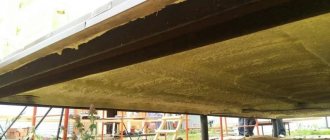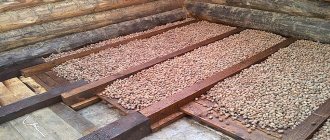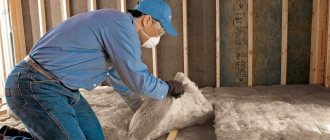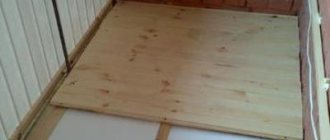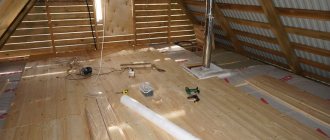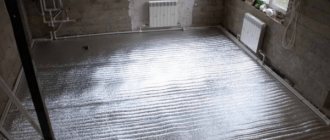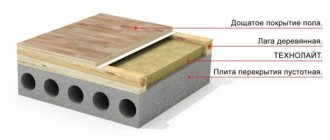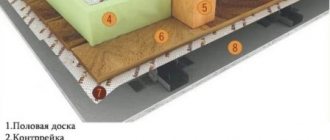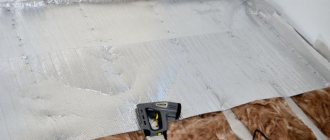Insulation
Date of publication: 12/24/2015
4
30850
- Frame building walls
- Materials you can use
- Properties of mineral wool affecting its quality
- Properties of foam plastic
- Properties of penoizol - liquid foam
In order to keep a frame building warm in winter, it is necessary to properly insulate the house. It is important that the thickness of the frame walls is sufficient and the density of the laid insulation is suitable.
Insulation of a frame building
Technical parameters of insulation materials
Insulation is selected according to its technical characteristics.
Characteristics:
density- thermal conductivity
- weight
- dimensions (length, width, thickness)
- flammability
- vapor permeability
- water absorption and many others.
The main parameter of insulation characteristics, which will be discussed in our article today, is density. The density of the insulation varies from 11 to 400 kg/m3.
Classification of insulation by density level
Usually everyone remembers school physics and associates the density of insulation with weight and mass.
The heavier the better, but this does not always follow true, depending on what factors and what operating conditions.
The choice of insulation directly depends on the budget, as paradoxical as it may sound, and of course the load on the structure as a whole or on a specific element.
Based on the density of the material, the following classification is distinguished:
Extra light
These include polystyrene foam (expanded polystyrene), which has a porous structure.
Designed for insulation in the cavities of walls, partitions, and for unloaded elements of the house.
Lungs
These are insulation materials based on mineral wool. They have a low thermal conductivity coefficient. Widely used in the construction of private houses and cottages.
Average
These types usually include foam glass. It is in the form of blocks and slabs, with high thermal insulation and sound insulation properties. It is not widespread in Russia.
Dense or hard
They also contain mineral wool, tightly pressed under high pressure. This type of insulation is used for outdoor work and is resistant to moisture and mechanical stress.
What insulation density should I choose?
This question often comes up during the construction of buildings; here you should rely on the standards provided for construction.
Up to 100 kg/m3
Insulation materials with a density from 11 to 35 kg/m3. They have a low specific gravity, are lightweight types of insulation, and are also very elastic. Recommended for use on roofs and roofing.- Insulation materials with a density from 35 to 75 kg/m3. It is used for insulating internal partitions, ceilings and walls of various shapes. It has found wide application for insulating the walls of frame houses.
- Insulation materials with a density from 75 to 100 kg/m3 . This type of insulation is widely used for wrapping ventilation pipes, heating mains, and oil pipelines.
From 100 to 150 kg/m3
- Insulation materials with a density from 100 to 125 kg/m3. For facades, they must be ventilated or have siding.
. It is used for insulating walls made of reinforced concrete, brick, as well as interfloor ceilings.
Insulation materials with a density from 125 to 150 kg/m3
From 150
- Insulation materials with a density from 150 to 175 kg/m3 . Used for cladding load-bearing structures.
- Insulation materials with a density from 175 to 225 kg/m3 . Due to its characteristics, it is used under a screed or as a rough layer under the finishing floor covering. Such materials have increased combustion resistance.
Properties of mineral wool affecting its quality
In order for insulation, such as mineral wool, to meet the necessary requirements, its density must be determined. Naturally, the higher it is, the better, but this affects the cost, increasing the price. This is easy to explain, since the density is influenced by the number of fibers contained in the material. In production, to achieve a higher level of density, you will have to increase material consumption.
Properties of mineral wool
The density of mineral wool as insulation is traditionally determined by the weight of 1 m3 of material. Today, different representatives supply products of varying densities to the construction market. What does this depend on? From the technological features of production used.
That is why, when choosing an insulation material, it is worth considering not only the thermal properties that must be observed, but also the features of the frame building itself or the house where the walls will be soundproofed and thermally insulated.
For example, if it is necessary to insulate a multi-storey residential building, mineral wool with a property of 35 to 40 kg/m3 will be used. For production facilities, denser materials are used. Professional architects and builders use special formulas with which they can calculate the required density of mineral wool, which will allow for high-quality insulation of a frame house.
What densities exist:
- Mineral mats – from 100 to 200 kg/m3,
- Mineral fiber – 100-150 kg/m3.
- Semi-rigid slabs – 70-300 kg/m3.
- Rigid mineral wool slabs - 100-400 kg/m3.
The higher this property, the better the thermal insulation. For example, due to their high density, rigid mineral boards are used to insulate walls and ceilings of residential buildings in difficult climatic conditions. The thermal conductivity of mineral wool depends on the density. The process of mineral wool insulation is discussed step by step here.
The second indicator is thickness. The higher the thickness, the better the heat-saving properties.
Special mention should be made of such material as isover. Its properties are described in the tables below:
Characteristics of isover
table 2
Main characteristics of insulation
As we all understand, most characteristics are interconnected. For example, thermal conductivity and density are not directly related to each other, as it seems at first glance.
As we all know, air is the best heat insulator, and how much the material contains, and how it is insulated from the outside air, determines the thermal conductivity coefficient.
It all depends on the structure of the material, so if we look at expanded polystyrene, it consists of air balls in the structure of expanded polystyrene and therefore a change in density has practically no effect on thermal conductivity.
And if we take mineral wool, the basis of which is basalt fibers. Then it consists of fibers that are intertwined, and air is contained between them, that is, the higher the density, the less free air and, accordingly, the higher thermal conductivity.
Noise insulation
Sound insulation directly depends on density; the less air permeability of the material, the better the sound absorption.
That is, the denser the material, the better, but such material weighs a lot and is difficult to process and is inconvenient to work with. But manufacturers have made specialized brands of insulation for internal sound insulation.
Izover, Rockwool made insulation from glass wool with the thinnest and longest threads, as well as basalt insulation with randomly twisted fibers and the density of such materials is about 50 kg/m3.
There are also brands with non-uniform hardness, one side is compacted on the outside, and the other is soft on the inside.
The density and thickness of the insulation has a direct relationship. That is, for different types of floors, different insulation materials are required, both in thickness and in terms of thermal insulation density and sound insulation.
From here we conclude that the thickness depends on its application:
- For roofing – 20-30 cm.
- For the basement - 5-15 cm.
- For the attic - 10-15 cm.
- For external walls – 5-10 cm.
The denser the material, the thinner the thickness.
Comparison of insulation materials
And now we will compare some insulation materials.
Mineral wool
One of the universal materials, density varies from 30 to 200 kg/m3.
It is used for finishing almost all structural elements of buildings. Available in water slabs, mats, rolls.
Most large mineral wool manufacturers (TechnoNIKOL, Knauf, Izorok) produce mineral insulation.
There are also manufacturers who produce mineral wool with certain characteristics.
Ursa, Knauf produce materials with a density from 11 to 35 kg/m3, which are suitable only for roofing work.
Polyethylene foam
It has a density of up to 25 kg/m3, and is used as a substrate for finishing floor coverings. There are options using foil, they have a density of about 55 kg/m3, they are mainly used for walls.
Styrofoam
The density of polystyrene foam is from 80 to 160 kg/m3, and is used for insulating walls and floors where sufficient strength is required. Available in the form of slabs of various sizes.
We must remember that for each object under construction, individual calculations are made for the choice of insulation. We recommend purchasing insulation from time-tested manufacturers.
Price
The average price of insulation per 1 m2 practically does not depend on the manufacturer and with a thickness of 50 mm is on average 100 rubles.
Insulation for walls of frame houses
The energy efficiency of houses built using frame technology is achieved by using heat insulators with low thermal conductivity. The set of rules SP 31-105-2002 recommends the use of materials in which this value does not exceed 0.1 W/m°C.
In this category:
- Stone (basalt) wool;
- Glass wool;
- Ecowool;
- Polystyrene foam (expanded polystyrene).
Mineral wool
To insulate the walls of frame houses, stone or glass wool is used. These are fibrous materials with a large number of air cavities. The porous structure ensures low thermal conductivity of the insulator, since heat transfer in gases is much lower than in solids.
Mineral wool is produced from the melt of basalt rocks or broken glass. Hydrophobizing (water-repellent) additives are added to the composition. Fibers with a diameter of 6-8 microns are formed in a centrifuge under the influence of a strong air flow. A carpet made of thin threads is treated with an organic binder based on phenol-formaldehyde or urea resins. Then it is cut into sheets 50-2000 mm long and 400-1000 mm wide. The thickness of finished products is up to 200 mm.
Slabs are marked according to density from PM 40 to PT 300. Soft, semi-rigid, rigid and hard insulation materials are used in various fields where the materials are subject to requirements not only for thermal conductivity, but also for strength and heat resistance. GOST 9573-2012 specifies the regulatory characteristics of thermal insulation made from mineral raw materials.
Mineral wool is a non-flammable material, so it is recommended for installation inside the walls of frame buildings.
Foam insulation
Thermal insulation products made from foam plastic - gas-filled plastic - are widely used to insulate the walls of frame buildings. Regulations allow their use for fastening to an external surface, since the initial raw material for production - polystyrene - is a flammable substance. Plaster or non-flammable cladding is a fire safety condition when using such insulation.
Polymer granules are catalyzed at high temperature and pressure with a mixture of freon and carbon dioxide. A mass similar to whipped cream is formed into products with a microporous structure by extrusion - squeezing through molds.
The material has low thermal conductivity and water absorption, durability, biological stability, lightness and strength. Marked depending on density. The lightest are PPS 10 slabs, their specific weight is only 10 kg/m³.
The heaviest polystyrene foam is PPS 45. A cubic meter of this material weighs 45 kg.
Standard product sizes are 60x120 cm. The construction industry produces slabs with a length of more than 2 m, a width of over 1 m, and a thickness of 20-100 mm. Compressive strength – from 40 to 350 kPa. The thermal conductivity coefficient does not exceed 0.044 W/m°C, self-combustion time is 1-4 s. Technical conditions for thermal insulating polystyrene foam boards are regulated by GOST 15588-2014.
Ecowool
Cellulose insulation received this name due to its external resemblance to cotton wool and economically viable raw materials. 80% of it consists of waste paper, the rest is low-toxic, non-volatile antiseptics and fire retardants.
Ecowool has low thermal conductivity (at the level of mineral wool), is environmentally friendly, and is not afraid of moisture. The capillary structure of the material restores its properties after drying. The density of cellulose insulation is 28-65 kg/m³, flammability group G2 is moderate. A natural polymer treated with brown (sodium salt of boric acid) ignites, but the fire quickly dies out.
In our country, ecowool has been used since 1992. Its production is growing, technological lines include processing of recyclable materials, grinding, mixing with boric acid and borax, and packaging.
There are 3 installation methods:
- Manual laying on horizontal surfaces;
- Dry blowing with a special installation;
- Spraying wet cellulose onto vertical and inclined surfaces.
The latter option is preferable for the walls of a frame house, as it allows you to control the quality of installation. The resulting smooth surface is ready for further finishing after 12 hours.
Ecowool meets the requirements of domestic GOST 16381-77.
Other materials
To insulate frames, polyurethane foam is used in the form of sheets with locking edges or spray foam. It is non-flammable, penetrates well into small crevices, has high adhesion, environmental friendliness, and low thermal conductivity.
Cement-bonded fiberboards with a density of 600 kg/m³ are used to sheathe internal partitions, and high-density ones (950-1050 kg/m³) are used to insulate external walls. The material is non-flammable, durable, and lasts up to 50 years. The composition does not contain phenol-formaldehyde resins or other organic compounds that can release substances toxic to humans.
